Applications often require different priorities: some prefer images are saved directly to the computer so there is no need to transfer media between the microscope and the computer. Others may want the microscope system to have minimal wired connections, so would benefit from a standalone unit that has built in software and image saving capabilities. When deciding on a digital microscope, it is important to consider the different output options the microscope camera offers and align them with your application’s demands.
Priority: A Completely Functional Standalone Microscope (HDMI Output)
With the exception of a few, most digital microscopes have HDMI output, which supports a direct connection to a monitor with HDMI input and bypasses the need to connect to a computer. These digital microscopes’ camera settings are controlled by a mouse connected to their USB port or directly on the camera’s hardware, allowing systems instantaneous live inspections at your work benchtop or right on the production line.
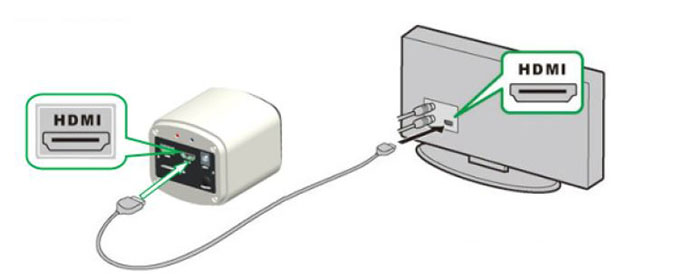
Digital microscopes with HDMI output usually come with the ability to save images directly onto their camera. The images are saved either to an inserted SD card or a USB drive connected to the USB port. Additionally, the microscopes may include built-in, integrated measurement software to provide complete functionality as a standalone unit. These features enable thorough documentation and quantitative analysis for accurate inspection on the spot and to provide resources for future training.
Our HD800 HD 1080p series feature manual focus digital microscopes with HDMI output, SD card for media storage and built-in measurement software. Our 4K Ultra HD digital microscopes are also best used when directly connected to 4K monitor through HDMI in order to fully experience the benefits of a 4K UHD system’s higher pixel count. The 4K400 series are the HD800 series’ 4K equivalents, complete with SD card and built-software to maximize inspection efficiency.
If your digital microscope application will only be used for live inspections and does not to require image capture or measurement features, our pure HDMI-only output models, such as the HD 1080p HD700 series, or the 4K Ultra HD 4K300 series, may be suitable for your needs. For an auto focus pure HDMI model with motorized zoom, you can consider the HDAF600.
Priority: Digital Microscope Operation Through the Computer (Various Output Options)
While it may be important for some to have a digital microscope that isn’t dependent on a computer connection for operation, others may prefer to have the microscope hooked up to the computer. A connection to the computer will allow images and videos to be saved directly onto the computer, eliminating the need to transfer the necessary files to complete your work. Computer-side operation software may also have advanced measurement and image processing capabilities not available on the built-in camera-side software.
USB 2.0 and USB 3.0 Output Connection
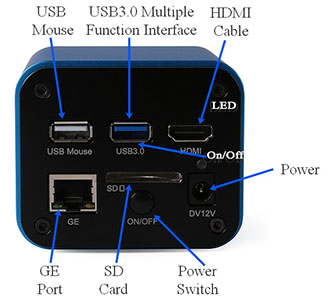
There are numerous ways a digital microscope can be connected to a computer; the most common interface is through USB output. At the bare minimum, all modern computers will have USB 2.0 ports that support this type of connection. Our HD800 HD 1080p series can hook up to a computer via USB port when needed.
New digital microscope cameras may feature USB 3.0 ports that will serve up faster data transfer speed (5Gb/s) when they are connected to a USB 3.0 input port on the computer side. Because processing 4K imaging often requires more power, USB 3.0 connection is required to operate the manual focus 4K400 and auto focus 4KAF400 digital microscopes series from the computer. Alternatively, a pure USB 3.0 microscope system like the USB306 system is designed to maximize the benefits of USB 3.0 and serve 41 fps high refresh rate valuable for real time viewing.
USB digital microscopes are also available in handheld portable forms (Dino-Lite) that are great for inspections that require mobility and easy angle manipulation. Dino-Lite digital microscopes come with a wide range of features to accommodate for applications in professional environments (industrial, technology, quality control, science, research forensics, etc.) as well as casual hobbyists (coin collecting, jewelry, antique appraisals, etc.). Some features include: 5 MP resolution, extended depth of focus, far working distance, coaxial lighting, UV/IR lighting, and different output options, like USB 3.0 and wireless ready.
Wi-Fi Wireless Connection
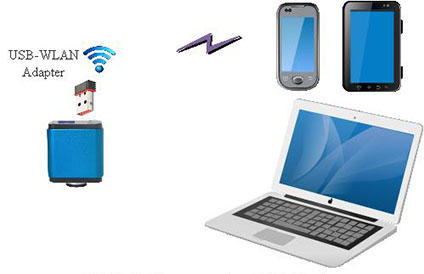
For those who would like to have the advantages of operating your microscope directly from the computer but are concerned about cable management and limitations: there are a rising number of digital microscope options available with Wi-Fi wireless connectivity. Most commonly, a USB Wi-Fi adapter is inserted into the USB port (where you would normally plug in the USB mouse when using system as a standalone unit) of the microscope camera, which then allows the microscope to connect wirelessly to a mobile device or computer for live inspections. Our HDAF200 HD 1080p auto focus series, 4K400 manual focus, and 4KAF400 auto focus 4K Ultra HD digital microscope series all have the USB Wi-Fi adapter option to connect the microscope camera to a computer for PC-side operations, or a mobile device for viewing on a portable screen.
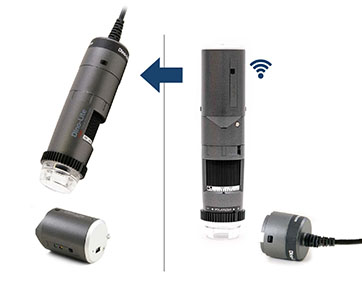
Although the majority of the Dino-Lite handheld digital microscope units are USB connection type, certain models are designed to also be wireless-ready. If you know you will need a wireless connection, you can purchase the models starting with “WF”, which will include the wireless adapter module as well as a module for wired USB type connection. If you are currently fine with a wired USB connection but still would like to have the option of eventually adding the wireless module in the future, you can choose a model starting with “AF”, and get the wireless module WF-20 later when you’re ready to move forward with wireless connection.
In addition to not having to deal with cables, a wireless connection allows remote access to the camera, giving you the freedom to conduct inspections from the comfort of your desk instead of where the microscope is stationed. This is especially helpful if the microscope needs to be set up in an enclosure or along the production line where additional personnel on the floor or accessing the enclosure may cause disruptions to the workflow.
Ethernet Connection
A significantly less common method for computer-side operation is the Ethernet connection. An Ethernet connection allows the camera to connect to a network for easy file transfer onto the devices or servers on the same network to improve workflow efficiency.
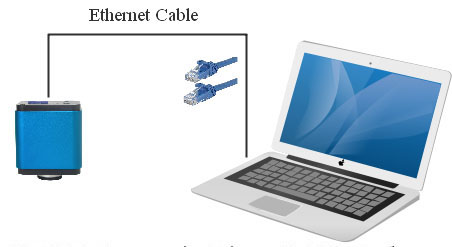
Our 4K400 manual focus and 4KAF400 auto focus 4K Ultra HD systems both offer direct LAN connection to the computer via Gigabit Ethernet port, which provides a data transfer rate of 1000 Mb/s. When multiple cameras are connected to a router, they also open the door to multi-camera casting, allowing any computers connected to the same router to access and control the camera remotely.
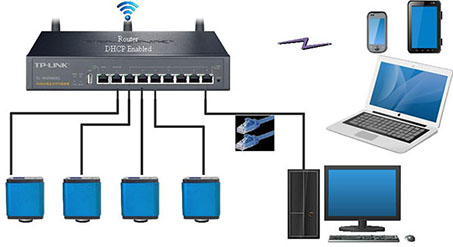
The Omni-Core auto focus digital microscope also supports networking capabilities via Ethernet port, providing the option to save directly onto the server or cloud for effortless file retrieval from your desktop.
Benefits of Operating the Digital Microscope While Connected to PC
Image Stitching and Extended Depth of Focus
The built-in software’s features on our digital microscopes are programmed to rival the capabilities on the PC-side software, so there are no disadvantages from using the digital microscope as a standalone inspection unit instead of connecting it to a computer. However, there are two notable additional image processing features on the PC-side software that many users find appealing for their application: image stitching and extended depth of focus
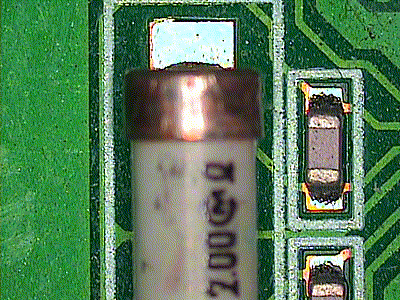
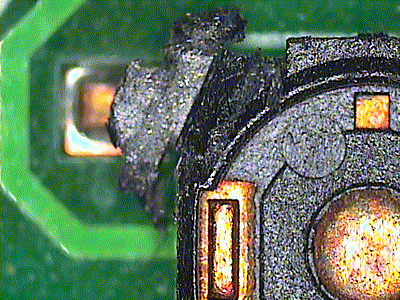
Image Stitching (left) and Extended Depth of Focus (right)
If your application requires a large field of view and high quality image capture, using image stitching will produce the desired image by piecing multiple images together to form one larger image. This eliminates the loss of quality that may come from trying to capture the large field of view at a lower magnification.
If the component you’re inspecting has different features on varying planes, extended depth of focus will help create one image in which everything in that specific area is in focus. This feature stacks the multiple images you’ve taken at different focal points and presents the sharpest elements of each photo in one superior image with extended depth of focus.
High Volume Documentation and Data Analysis
Often times, the inspection process doesn’t just stop at the live inspection. If your image captures and measurement data will be used to support your inspection findings in a report, you may prefer to have a direct connection to the computer/network so that the images, videos and data are saved directly on there for future reference. This removes the extra step of having to transfer the necessary files over from the SD card or USB thumb drive when you are ready to implement the images and data into your reports
Some Exceptions: 4K Ultra HD Digital Microscopes
It should be noted that while our 4K Ultra HD digital microscopes offer the most output options (i.e. HDMI, USB 3.0, Wi-Fi, and Ethernet port connections) out of all the models we carry, 4K Ultra HD digital microscopes work best when they are directly connected to a large 4K monitor via HDMI output. The larger monitor size will help take advantage of the 4K Ultra HD resolution’s higher pixel count for high quality, clear inspections.
Although connecting the 4K system to the computer will give you access to the image stitching and extended depth of focus image processing features, the computer you are operating from most likely will not be using a 4K monitor screen. So while images and videos will still save in 4K resolution, your live viewing and playback of the saved media will be limited by monitor’s HD 1080p resolution.
For assistance with choosing what microscopes satisfy your application’s output requirements, contact us today!
